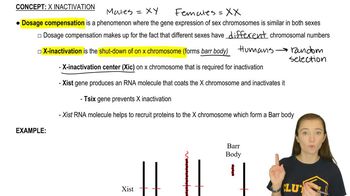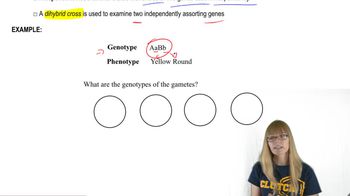Table of contents
- 1. Introduction to Genetics51m
- 2. Mendel's Laws of Inheritance3h 37m
- 3. Extensions to Mendelian Inheritance2h 41m
- 4. Genetic Mapping and Linkage2h 28m
- 5. Genetics of Bacteria and Viruses1h 21m
- 6. Chromosomal Variation1h 48m
- 7. DNA and Chromosome Structure56m
- 8. DNA Replication1h 10m
- 9. Mitosis and Meiosis1h 34m
- 10. Transcription1h 0m
- 11. Translation58m
- 12. Gene Regulation in Prokaryotes1h 19m
- 13. Gene Regulation in Eukaryotes44m
- 14. Genetic Control of Development44m
- 15. Genomes and Genomics1h 50m
- 16. Transposable Elements47m
- 17. Mutation, Repair, and Recombination1h 6m
- 18. Molecular Genetic Tools19m
- 19. Cancer Genetics29m
- 20. Quantitative Genetics1h 26m
- 21. Population Genetics50m
- 22. Evolutionary Genetics29m
2. Mendel's Laws of Inheritance
Sex-Linked Genes
Problem 28a
Textbook Question
In Drosophila, the X-linked echinus eye phenotype disrupts formation of facets and is recessive to wild-type eye. Autosomal recessive traits vestigial wing and ebony body assort independently of one another. Examine the progeny from the three crosses shown below, and identify the genotype of parents in each cross. <image>
 Verified step by step guidance
Verified step by step guidance1
span>1. Understand the genetic traits involved: The echinus eye phenotype is X-linked and recessive, while vestigial wing and ebony body are autosomal recessive traits that assort independently.</span
span>2. Analyze the progeny from each cross: Look at the phenotypic ratios of the offspring to determine the possible genotypes of the parents. Consider how the X-linked and autosomal traits are inherited.</span
span>3. For the X-linked echinus eye trait, remember that males have one X chromosome and females have two. Use this information to deduce the genotypes of the parents based on the presence or absence of the echinus phenotype in male and female offspring.</span
span>4. For the autosomal traits (vestigial wing and ebony body), use Mendelian inheritance patterns to determine the genotypes of the parents. Consider the phenotypic ratios of the offspring to infer whether the parents are homozygous or heterozygous for these traits.</span
span>5. Combine the information from the X-linked and autosomal traits to construct the most likely genotypes for each parent in the crosses. Ensure that the genotypes are consistent with the observed phenotypes in the progeny.</span
Recommended similar problem, with video answer:
 Verified Solution
Verified SolutionThis video solution was recommended by our tutors as helpful for the problem above
Video duration:
1mPlay a video:
Was this helpful?
Key Concepts
Here are the essential concepts you must grasp in order to answer the question correctly.
X-linked Inheritance
X-linked inheritance refers to the pattern of inheritance for genes located on the X chromosome. In Drosophila, traits such as the echinus eye phenotype are determined by alleles on the X chromosome. Since males have one X chromosome, they express X-linked traits more readily, especially if the trait is recessive, as they lack a second X to mask the effect.
Recommended video:
Guided course

X-Inactivation
Independent Assortment
Independent assortment is a fundamental principle of genetics stating that alleles for different traits segregate independently of one another during gamete formation. In the context of the Drosophila traits mentioned, the autosomal recessive traits vestigial wing and ebony body do not influence each other's inheritance, allowing for a variety of combinations in the progeny.
Recommended video:
Guided course

Gamete Genetics and Independent Assortment
Genotype and Phenotype
The genotype refers to the genetic constitution of an organism, while the phenotype is the observable expression of that genotype, influenced by both genetics and the environment. Understanding the genotypes of the parent Drosophila in the crosses is crucial for predicting the phenotypes of their offspring, particularly in the context of dominant and recessive traits.
Recommended video:
Guided course

Gamete Genotypes

 7:56m
7:56mWatch next
Master Sex-Linked Genes with a bite sized video explanation from Kylia Goodner
Start learningRelated Videos
Related Practice



